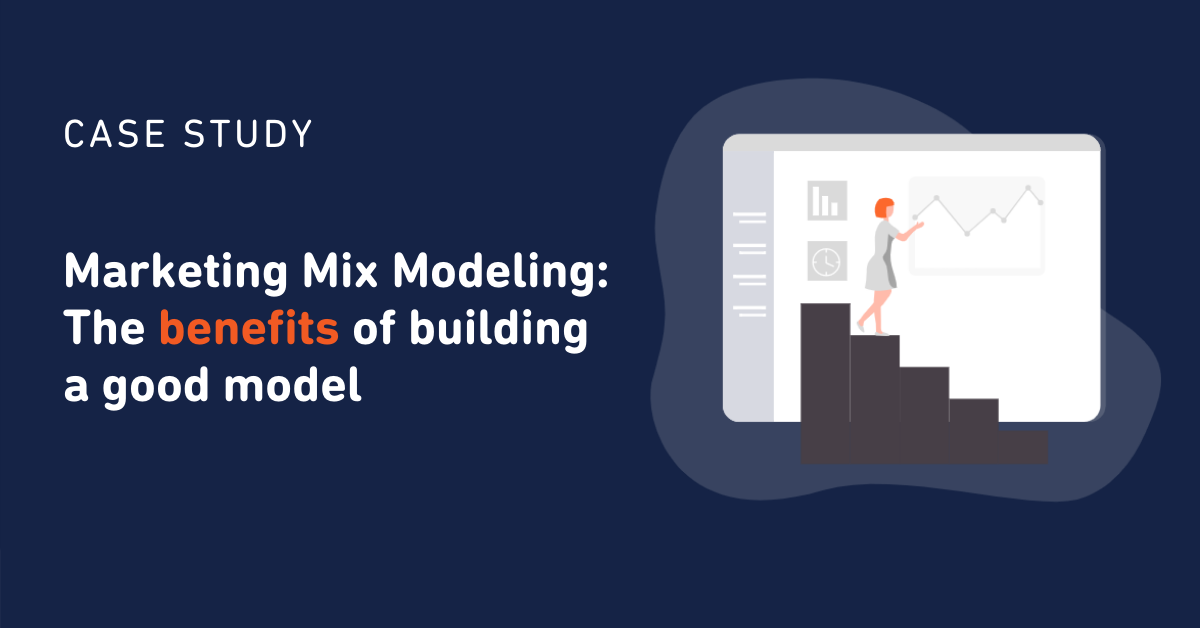What are the benefits of a good Marketing Mix Model?
Some of the benefits of marketing mix analysis are fairly obvious. A good marketing mix model should provide:
- Accurate, reliable results that can be used to inform key decisions
- Detailed insights about the things that matter
- An understanding of how consumers respond to marketing activities and interact with your brand
- The ability to test different scenarios before implementing them and ensure that your budget is allocated most efficiently.
- MMM is backward-looking, measuring the impact of activities that have already occurred. However, the results are frequently fed into forecasting and optimization software to inform future marketing plans.
What are some of the less obvious advantages of Marketing Mix Modeling? Well, before commencing any analysis, data needs to be collated, processed, and verified. Now, this might not sound overly appealing, but if done properly, it can save an enormous amount of time and uncover any reporting inaccuracies, as well as provide some useful insights.
We believe that it is vitally important to chart and check your data before embarking on any analysis. It’s always a surprise how few people actually take the time to look at their data on a time-series chart and check that it makes sense. Often, when showing people their data in our software for the first time, we hear things like: “I didn’t know we’d done that with our TV” “Is that really what our sales look like?”.
Data anomalies that we have recently uncovered with our clients include:
%20(3).png?width=650&name=Data%20Anomalies%20(Marketing%20Mix%20Modeling)%20(3).png)
Visualizing the data can help you to verify and understand the information that you have collated and will be using in your analysis. That extra understanding is vital in creating a good model.
As an example, one UK client achieved a surprising and useful insight into the relationship between its online and offline inquiries and sales. As a financial services company, they had always assumed that customers were divided between telephone enquirers and potential online buyers. The assumption was that those who telephoned the call center were simply trying to find out a price for their service. But what the analytics helped to flush out was the fact that many of those who called, ostensibly making their first contact, to make an inquiry and get a quote, had already checked online. They knew fairly accurately – often from using so-called online aggregator websites like LowerMyBills.com, comparethemarket.com, or moneysupermarket.com – what this company, and, indeed, its rivals, would normally charge.

The real point of the call, it turned out, was people asking themselves: “Is there a chance I can get a better price if I talk to a human being?” The company had actually been behaving as if there were three discrete sets of potential customers: those who phone the call center, those who go direct to the company’s website, and those who go to the aggregators. The assumption had been that anyone who called up didn’t know the price. But the analytics proved that these were not three separate populations. The way to persuade more people to come and buy direct, via the phone or the website, was, paradoxically, to lower the price quoted online. Our client could avoid paying out so much in referral fees to the aggregator sites by lowering the prices quoted to customers via the online aggregators. This would stimulate more calls to the call center and more direct sales.
This was an interesting and important insight. If we think of it solely in terms of correlation versus causation, why would there ever be a correlation between the price offered and the number of calls to the call center? If lowering the price quoted online reliably induces more people to call, it can only be because these people who pick up the phone know what the online price is. If they didn’t, then changing that price could not affect their behavior. This was an insight that had never been part of the company’s thinking, and it gave the CMO an option that had not been considered before. It enabled the marketing team to put forward a sound business case, strongly supported by the data, in favor of cutting prices across all channels to generate increased volumes and higher profits. The in-house marketers were certainly not expecting this result. But it was a clear example of the way valuable nuggets can sometimes fall out of the data when a pattern emerges that no one was predicting.
What are the issues with bad marketing mix models, and how can we solve them?
Unfortunately, not all marketing mix models that are produced are “good models”. We’ve just looked at some of the common errors that can be found in any dataset, and as the saying goes, “garbage in, garbage out”.
- If the data that is fed into the analysis is wrong, then the conclusions drawn from that analysis will also be inaccurate. This can lead people to make the wrong decisions, which can impact the brand and its profitability.
- Another issue commonly encountered is that of underdetermination. This is where the data can support competing theories, or explanations, as to what is causing the movements in the modeled KPI.
We have a function in our modeling software, strataQED, called “save multiple models”. This enables you to run hundreds of models and investigate not just the “point” estimate that would be gained from creating a single model, but also the spread of estimates.
Charting the results shows whether underdetermination is present. In other words, is it possible that some models tell one story and other models tell a different one? To determine the correct set of results, you must have in-depth experience of the market and, ultimately, the consumers you are modeling. Modeling cannot be done in a vacuum, devoid of market context, as this often leads to poor or misleading results.
.png?width=600&name=marketing%20mix%20modeling%20blog%20(1).png)
What are the key benefits of our solution, strataQED?
There are several pieces of software available for conducting Marketing Mix Modeling analysis. At ScanmarQED, we have our own purpose-built offering – strataQED. The philosophy behind strataQED is that it should be quick to learn, user-friendly, and offer complete transparency.
You can quickly test hundreds of models using our automated model search function. By setting a series of common-sense parameters about how consumers are likely to respond to different marketing activities, you can quickly create a model that is statistically valid as well as making business and common sense. You can view and customize all the assumptions and transformations made in strataQED, and easily share files with colleagues and clients to build their trust in the process.
One of the features that sets our Marketing Mix Modeling software apart from other solutions is that in addition to reporting the model statistics, you can immediately see how each activity contributes to your modeled KPI, view the return on investment (ROI) for each of your marketing channels, and examine the response curves for each driver to determine the point at which diminishing returns set in. As you update your model, these reports automatically refresh so that you can quickly and easily assess the impact of the changes that have been made to the model.
What’s more, our modeling software links harmoniously with our forecasting and optimization solutions, enabling a seamless transition from analyzing previous activities to predicting the impact of your marketing plans.
How do we support clients with building good models?
We believe that the benefits of Marketing Mix Modeling should be easily accessible – for both the experienced modeler and the novice. We work with our users to ensure that they quickly become confident and competent users of our tools. For the complete novice, we work side-by-side to guide them through the process, from determining the objectives of the analysis to presenting the results and making recommendations for how to improve the effectiveness and efficiency of their marketing budget. For the experienced modeler, we provide a sounding board for them to discuss any ideas and challenges that arise during a project and can also provide quality assurance by reviewing their findings. We can also step in and provide extra bandwidth when users lack the time and resources to complete the work internally.
We offer a unique service whereby users can have the best of both worlds; benefiting from the independence and flexibility of an internal analytics capability and the experience that an external consultancy can offer. Some of our clients are self-sufficient, for others we conduct modeling as a service with them involved throughout the process to ensure their buy-in and to utilize their brand and category knowledge. Sometimes a mix of the two is more appropriate. Users can easily move between the different ways of operating, as and when required. We are happy to guide clients through the transition from using an external consultancy to developing an internal capability, at a pace that is right for them.
As an example, we have worked with a leading insurance provider in the UK for nearly 10 years. During that time, we have:
- worked side-by-side with their analytics team to deliver the analysis
- provided “modeling as a service”, when a key team member was on maternity leave and when there were too many other demands on the team’s time
- enabled them to run the analysis independently
- and various levels in between!
What software are our clients using for Marketing Mix Modeling?
We have a variety of software to support our clients, depending upon their needs and the questions that they need to answer. Many users start with our Marketing Mix Modeling tool, strataQED, paired with one of our forecasting and optimization solutions, portfolioQED and optimiseQED. Others have added our online reporting tool and dashboarding solution, MMM2Go
“If we had to do the same work without the QED tools, we would need at least 10 people, instead of 4”. - Chris Mee Head of Marketing Analytics at Entain.
Now, with the ability to quickly build good quality econometric models, users can answer almost any question regarding business drivers and can effectively inform their marketing decisions.
If you have any questions related to marketing measurement and modeling, please contact us by clicking the button below, and we’ll be happy to discuss how we can help you and your organization.
Or request a demo of the software solutions we’ve discussed today.



.png)